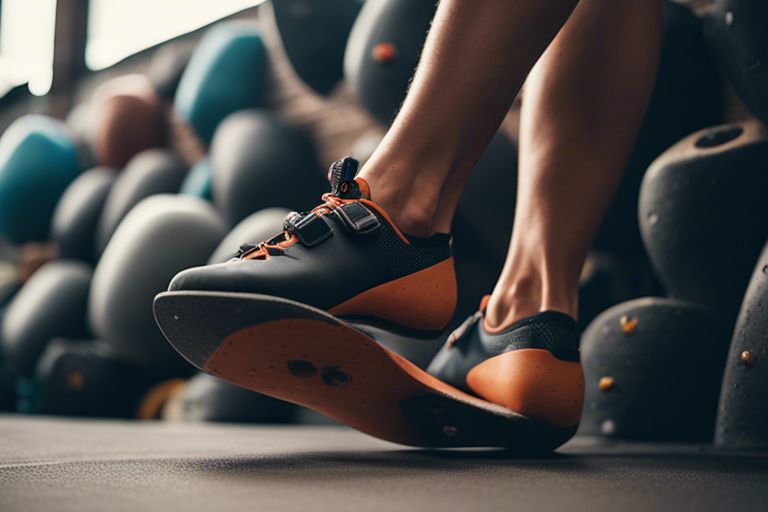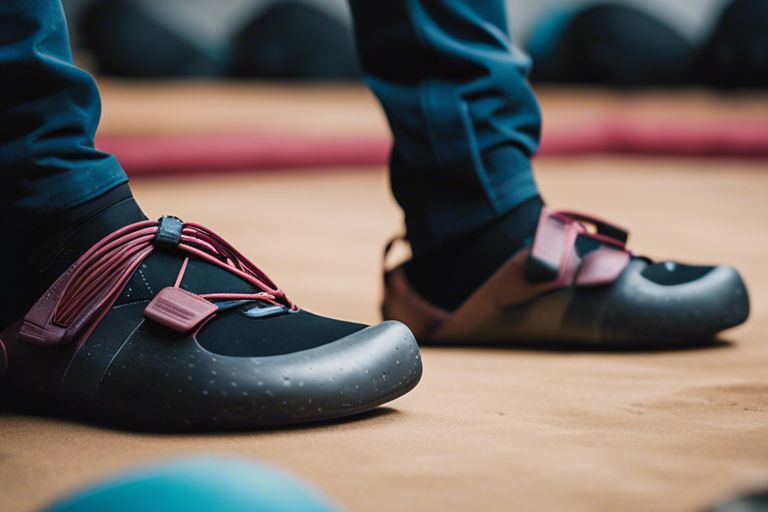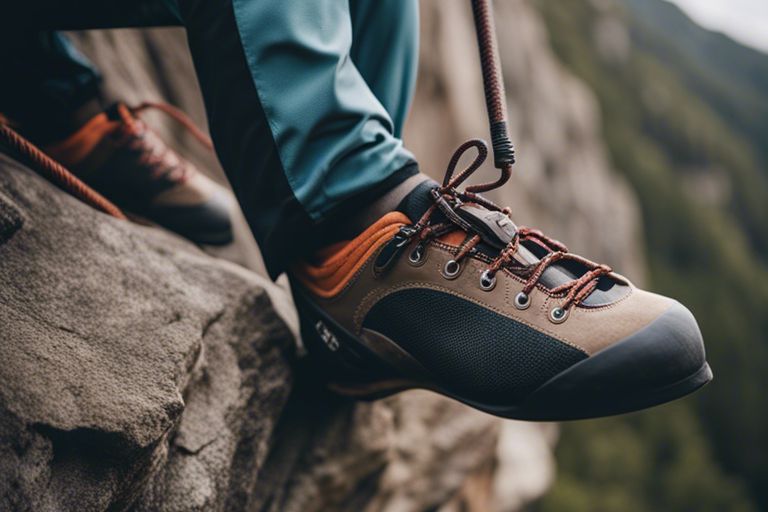Overwhelmed by the pain and discomfort of new climbing shoes? You can make the process of breaking them in much more bearable with these tips. By taking the time to customize the fit and gradually wear them in, you’ll have a pair of climbing shoes that feel like a second skin in no time.
Key Takeaways:
- Use water and heat: A common method to break in climbing shoes is to wet them with lukewarm water and then wear them until they dry.
- Focus on pressure points: Pay attention to any tight spots on your feet when breaking in climbing shoes and target those areas for better comfort.
- Be patient: Breaking in climbing shoes can take time, so be patient and consistent with your efforts to achieve the perfect fit.

Understanding the Importance of Breaking in Climbing Shoes
Why Breaking in is Crucial for Comfort and Performance
To get the most out of your climbing shoes, it’s crucial to break them in properly. This process not only ensures that your shoes are comfortable on your feet but also impacts your performance on the wall. When you break in your climbing shoes correctly, you allow the materials to adjust to your feet, providing a better fit and enhancing your overall experience while climbing.
Common Mistakes to Avoid When Breaking in Climbing Shoes
While breaking in your climbing shoes, some common mistakes can hinder the process and even damage your shoes. One common error is trying to rush the break-in period by wearing your shoes for extended periods from the start. This can lead to discomfort, blisters, and potential damage to the shoes. Another mistake to avoid is exposing your climbing shoes to extreme heat, as this can cause the materials to warp or weaken, affecting the shoe’s performance and durability.
Breaking in climbing shoes should be a gradual process, allowing your feet and the materials of the shoes to adjust slowly. Avoid wearing them for long sessions initially and instead increase the wearing time gradually to ensure a proper break-in without compromising the shoes’ integrity.
Factors to Consider When Breaking in Climbing Shoes
Clearly, there are several key factors to consider when breaking in climbing shoes. These factors can greatly impact the time it takes for your shoes to feel comfortable and perform optimally on the rock. It’s imperative to take these considerations into account to ensure a smooth and effective break-in process.
Material and Construction of the Shoes
Shoes made from different materials and constructed in various styles will require different break-in times. For example, leather shoes tend to stretch and conform to your feet over time, while synthetic shoes may not stretch as much. The way the shoes are constructed, such as the type of rand or closure system, can also affect how they feel on your feet initially.
Recognizing the material and construction of your climbing shoes is crucial in understanding how they will break in and adjust to your feet.
Your Foot Type and Climbing Style
You should also consider your foot type and climbing style when breaking in climbing shoes. The shape of your feet, whether wide or narrow, high-arched or flat, can impact how the shoes fit and feel. Additionally, the type of climbing you do, whether it’s bouldering, sport climbing, or trad climbing, can affect the break-in process. For instance, aggressive shoes suited for bouldering might require a longer break-in period compared to more neutral shoes designed for all-day comfort.
This understanding can help you choose the right type of shoes for your foot type and climbing preferences, ultimately making the break-in process more tailored to your needs.
Environmental Factors Affecting Break-in Time
- Humidity and temperature in the climbing area
- Frequency and duration of climbing sessions
You may be surprised to learn that environmental factors can also play a role in how quickly your climbing shoes break in. Humidity and temperature in your climbing area can affect the elasticity of the materials in the shoes, potentially speeding up or slowing down the break-in process. Additionally, the frequency and duration of your climbing sessions can impact how quickly the shoes mold to your feet and become more comfortable.
- Perceiving and adapting to these environmental factors can help you anticipate how your shoes will break in and adjust your approach accordingly.
To optimize the break-in process for your climbing shoes, it’s crucial to consider the material and construction of the shoes, your foot type and climbing style, as well as the environmental factors that may affect break-in time. By taking these factors into account, you can better understand how to break in your climbing shoes effectively and ensure a comfortable and high-performing fit on the rock.
Pre-Break-in Preparation
Inspecting and Cleaning the Shoes
Inspecting your climbing shoes before breaking them in is crucial to ensure they are in good condition and free from any defects. Check for any loose threads, delamination, or damage to the sole that could affect the performance of the shoe. Cleaning your shoes before breaking them in is also important, as dirt and grime can hinder the break-in process. Use a soft brush to remove any dirt or debris from the shoes, and wipe them down with a damp cloth if necessary.
Softening the Shoes with Heat or Conditioners
With climbing shoes, you can soften them up before breaking them in by using heat or specific conditioners. Placing your shoes in the sun or using a hairdryer on a low setting can help soften the rubber and make the shoes more comfortable. Additionally, there are shoe-specific conditioners available in the market that can help soften the material of the shoes without compromising their performance.
Another way to soften your climbing shoes is by wearing them around your house for short periods before heading to the crag. This will allow the shoes to mold to your feet and become more comfortable over time.
Wearing the Right Socks for Break-in
PreBreakin a pair of thin socks can help protect your feet from blistering during the break-in process. Thin socks provide a layer of cushioning between your skin and the shoe, reducing friction and the likelihood of developing blisters. Make sure the socks fit snugly to avoid any bunching up inside the shoe, which could cause discomfort.
Cleaning your socks regularly is imperative to prevent any dirt or debris from transferring to your climbing shoes, which could affect their performance and longevity.
Breaking in Climbing Shoes: Tips and Techniques
After eagerly purchasing a new pair of climbing shoes, you’re likely excited to hit the rocks and test them out. However, breaking in climbing shoes is a crucial step to ensure comfort and performance on the crag. Understanding the right techniques can help you avoid unnecessary discomfort and potential blisters. Knowing how to break in your climbing shoes properly will make a significant difference in your climbing experience.
Gradual Wear and Tear: A Step-by-Step Guide
Assuming you’re ready to break in your new climbing shoes, it’s important to do so gradually to avoid discomfort and potential damage to the shoes. Here is a step-by-step guide to help you break in your climbing shoes effectively:
| Step | Action |
| 1 | Wear them around the house for short periods. |
| 2 | Climb easy routes indoors to get your feet used to the shoes. |
| 3 | Gradually increase climbing time and difficulty to fully break them in. |
Knowing the importance of gradual wear and tear in breaking in your climbing shoes will help you achieve the perfect fit and comfort for your climbing adventures.
Stretching and Shaping the Shoes for a Better Fit
For climbers, achieving the ideal fit in climbing shoes is crucial for maximizing performance and comfort. It can be beneficial to stretch and shape your shoes to conform better to the shape of your feet. This can help alleviate pressure points and discomfort while climbing.
Gradual stretching of specific areas in the shoes can improve the overall fit and feel. You can do this by wearing the shoes with thick socks or using a shoe stretcher designed for climbing shoes. This process can take time but can significantly enhance the comfort and performance of your shoes.
Using Break-in Aids and Accessories
To expedite the break-in process for your climbing shoes, you can utilize various break-in aids and accessories available in the market. Products like climbing shoe stretchers, shoe trees, or even specially formulated shoe stretch sprays can help accelerate the stretching process and make your shoes more comfortable to wear.
To ensure the effectiveness of these break-in aids, follow the instructions carefully and monitor the fit of your shoes regularly. By using these aids, you can break in your climbing shoes faster without compromising on comfort or performance.
Breaking in climbing shoes is an crucial step that requires patience and careful consideration to achieve the perfect fit and comfort for your climbing sessions. Whether you opt for gradual wear and tear, stretching and shaping, or using break-in aids, the goal is to make your climbing shoes feel like a natural extension of your feet, enabling you to focus on your climbs without any distractions.

Overcoming Common Break-in Challenges
Dealing with Discomfort and Pain
Clearly, breaking in climbing shoes can be a painful process, especially if you are not used to the snug fit required for climbing. To alleviate discomfort, wear your shoes for short periods at a time, gradually increasing the duration as your feet get accustomed to the pressure. You can also try wearing thin socks or using toe caps to provide some cushioning and protect your skin from irritation.
Managing Blistering and Hotspots
There’s a possibility of developing blisters and hotspots while breaking in your climbing shoes, especially if the shoes are rubbing against certain points on your feet. To prevent this, you can apply moleskin or blister pads to areas prone to irritation. Additionally, using a silicone-based lubricant on your feet can help reduce friction and minimize the chances of developing blisters.
The key to managing blistering and hotspots is to address any discomfort or irritation early on to prevent them from getting worse. It’s important to listen to your body and give your feet time to heal before continuing to break in your climbing shoes.
Addressing Fit Issues and Sizing Problems
Blistering, pain, and hotspots can often be attributed to fit issues and sizing problems with your climbing shoes. If your shoes are too tight, they can put excessive pressure on certain areas of your feet, leading to discomfort and blistering. On the other hand, shoes that are too loose can cause rubbing and instability, resulting in hotspots and potential injuries.
Challenges can arise when finding the right balance between a snug fit for performance and a comfortable fit for prolonged wear. Experiment with different lacing techniques, insoles, or even consider getting your shoes stretched by a professional to improve the fit and alleviate any sizing issues you may be experiencing.

Maintaining and Caring for Your Broken-in Shoes
Cleaning and Conditioning the Shoes Regularly
Your climbing shoes undergo a lot of wear and tear, which is why it’s imperative to clean and condition them regularly. The sweat and dirt accumulated in the shoes can not only cause them to smell but also break down the materials over time. To clean your shoes, gently scrub them with a soft brush and mild soap, then rinse thoroughly and let them air dry. Conditioning your shoes with a specialized climbing shoe conditioner will help maintain the flexibility and durability of the materials, ensuring they last longer.
Storing the Shoes Properly to Prevent Damage
Assuming you want your climbing shoes to remain in top condition, proper storage is crucial. Avoid leaving them in extreme temperatures or direct sunlight as this can cause the materials to degrade. Instead, store your shoes in a cool, dry place with good ventilation. Additionally, keeping them away from moisture and dust will help prevent any damage and preserve the integrity of the shoe’s construction.
Caring for your climbing shoes by following these storage tips will not only extend their lifespan but also ensure they are ready for your next climbing adventure whenever you are.
Extending the Life of Your Climbing Shoes
Now, to extend the life of your climbing shoes further, consider rotating between multiple pairs to reduce wear on each individual pair. This practice allows your shoes to dry out completely between uses, preventing bacteria growth and maintaining their shape and fit for longer. Additionally, being mindful of how you place your feet while climbing and avoiding unnecessary scuffing against rough surfaces can also help preserve the rubber soles and prevent premature wear and tear.
Conditioning your climbing shoes by practicing good maintenance habits and being cautious during climbs will not only save you money in the long run but also ensure you get the best performance out of your favorite pair for an extended period.
To wrap up
Conclusively, breaking in your climbing shoes is a crucial step to ensure they fit comfortably and perform well on the rock. By following these steps and being patient with the process, you can avoid unnecessary discomfort and blisters while climbing. Remember to gradually increase the time you spend wearing your shoes and use techniques like stretching and wearing them around the house to help speed up the breaking-in process.
Q: Why is it important to break in climbing shoes?
A: Breaking in climbing shoes helps mold them to the shape of your feet, increasing comfort and performance on the rock. It also allows the shoes to stretch slightly, providing a better fit over time.
Q: How can I break in my climbing shoes?
A: One common method is wearing them around the house for short periods of time to give the shoes a chance to soften and form to your feet. You can also try doing some light climbing or bouldering sessions to help speed up the process.
Q: Any tips for breaking in climbing shoes faster?
A: To break in climbing shoes faster, you can try wearing them with thin socks or using a shoe stretcher. Additionally, gently flexing and manipulating the shoes with your hands can help soften the material and make them more pliable.




